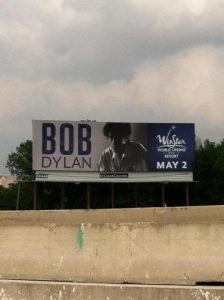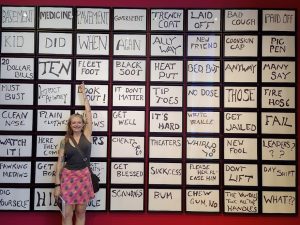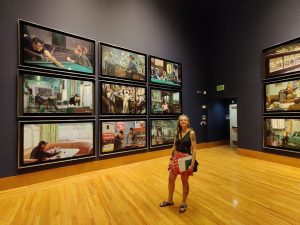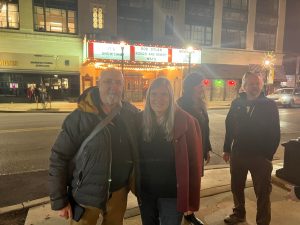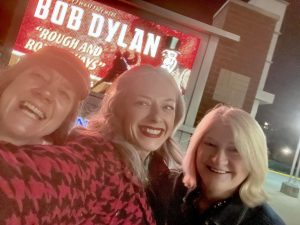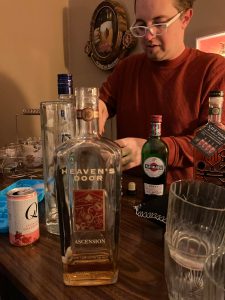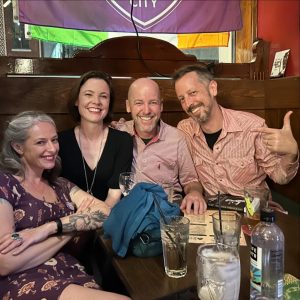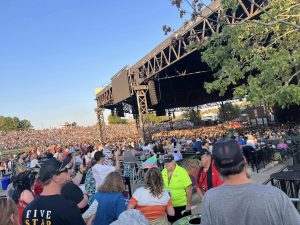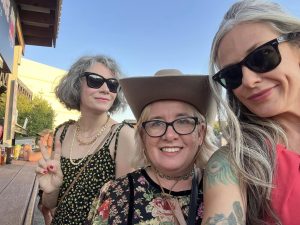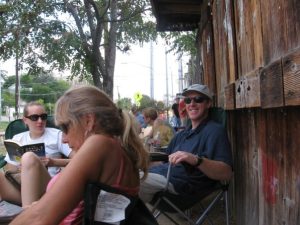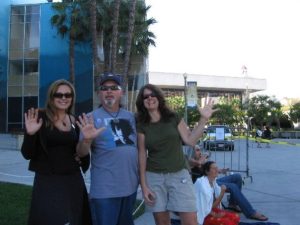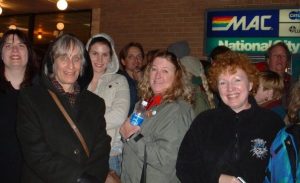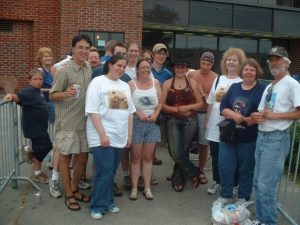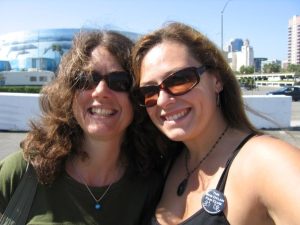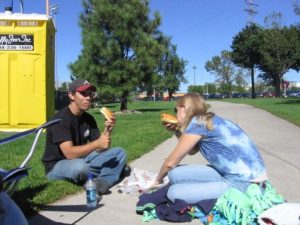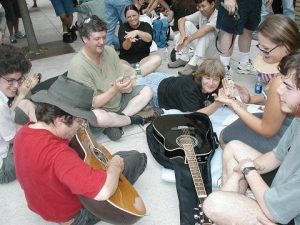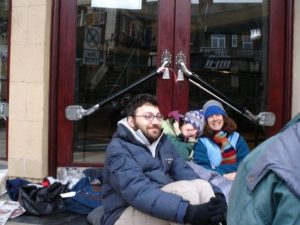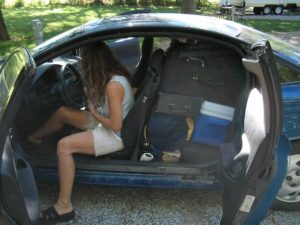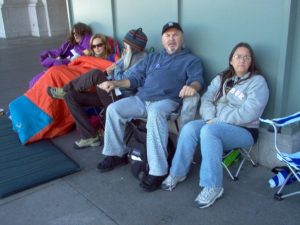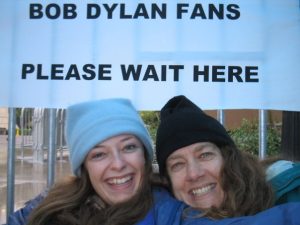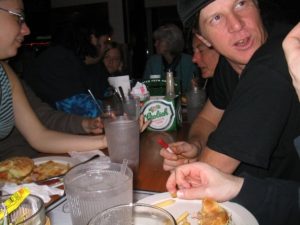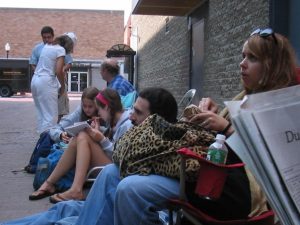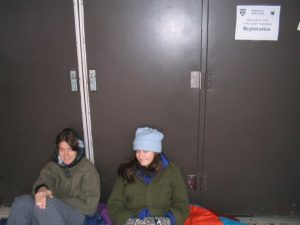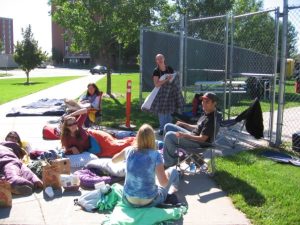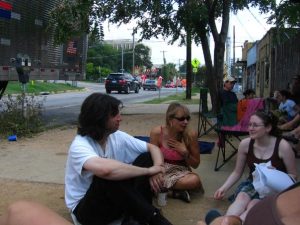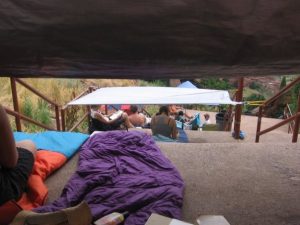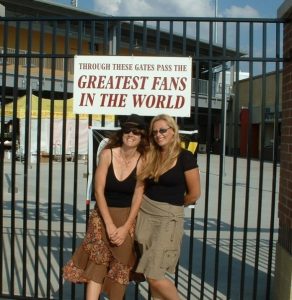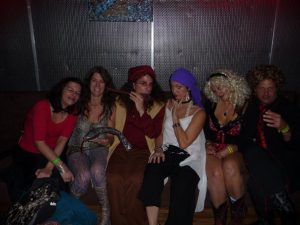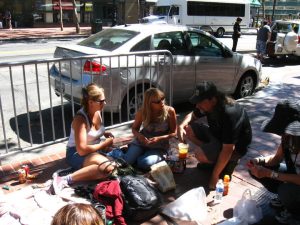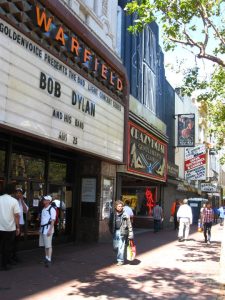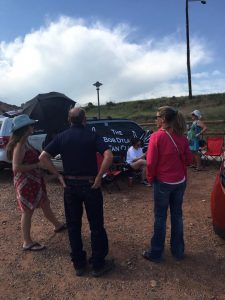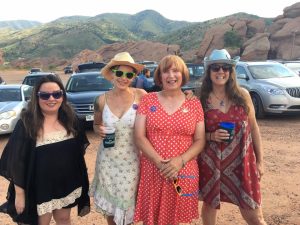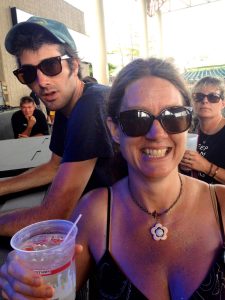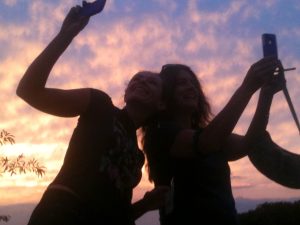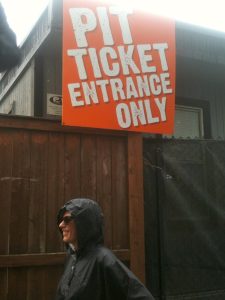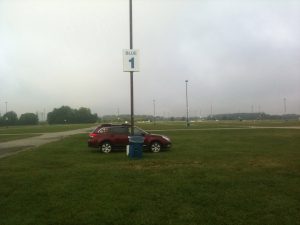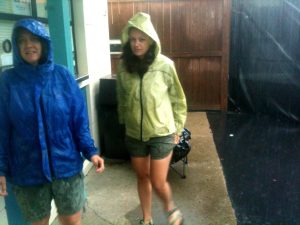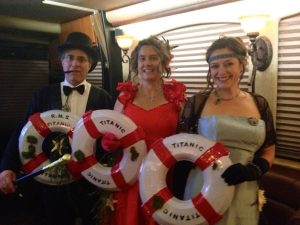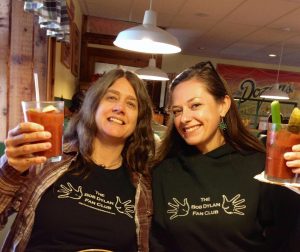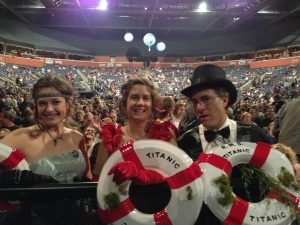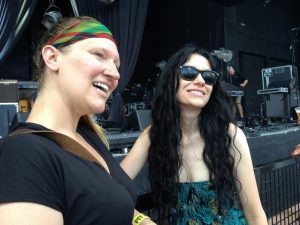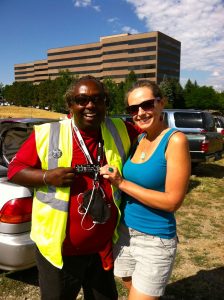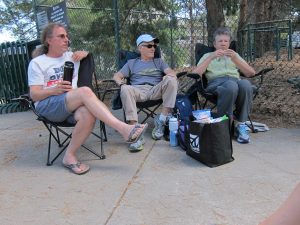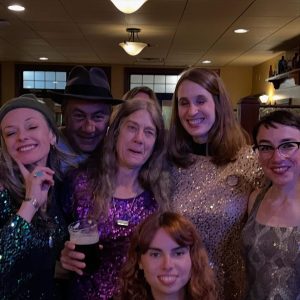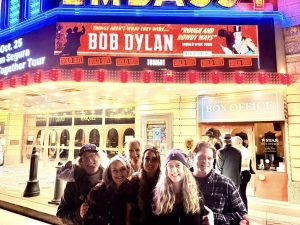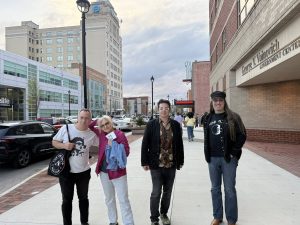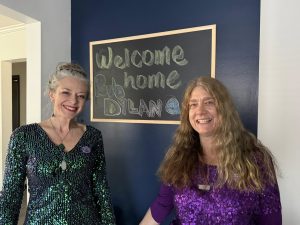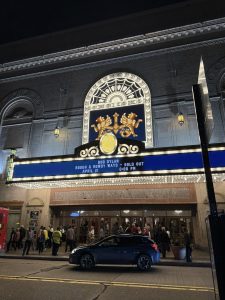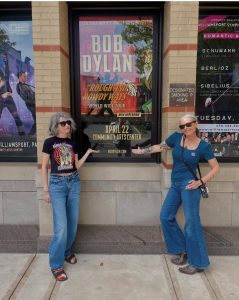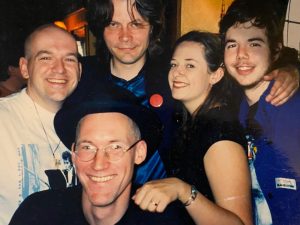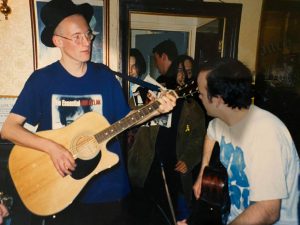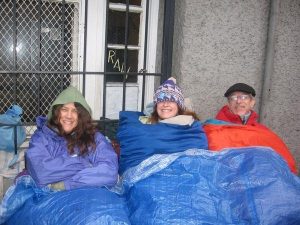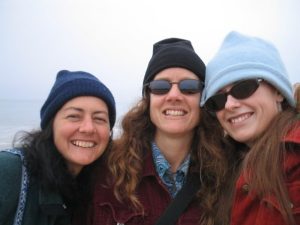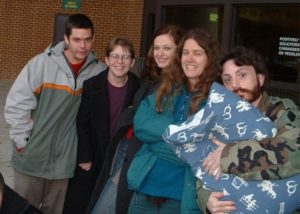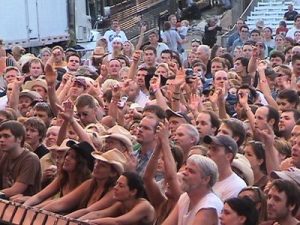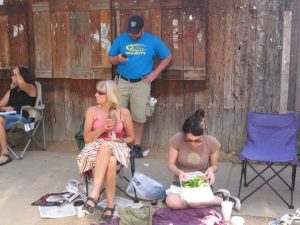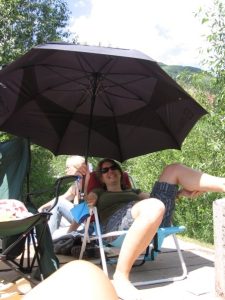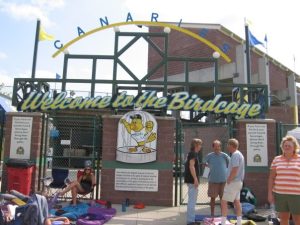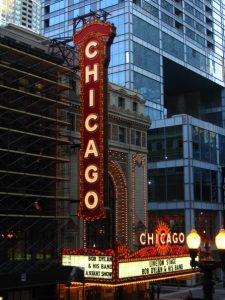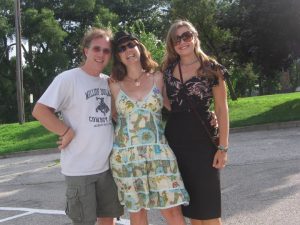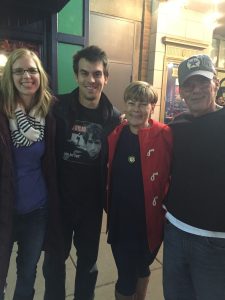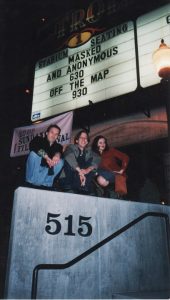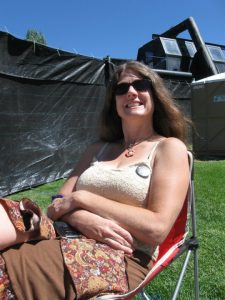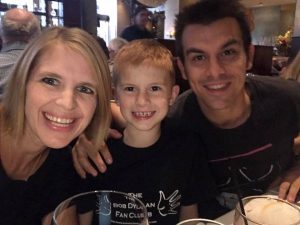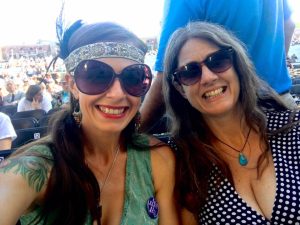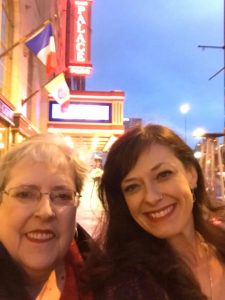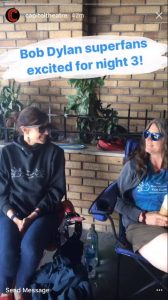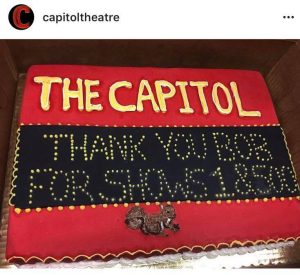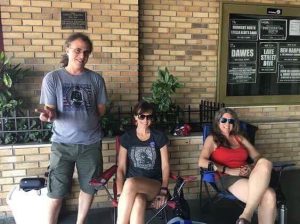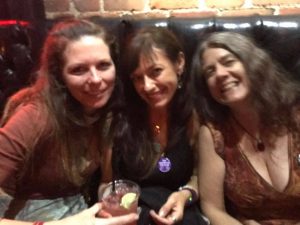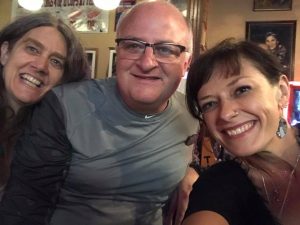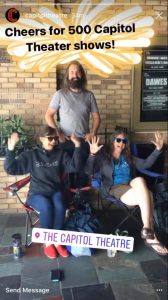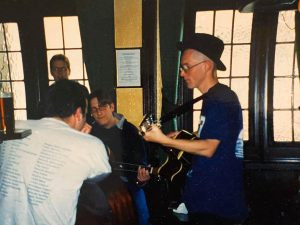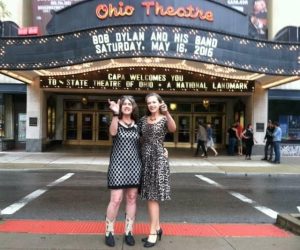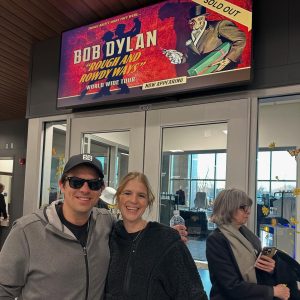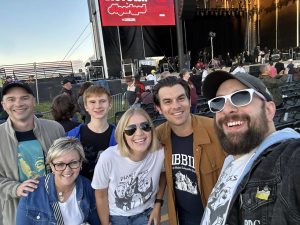For The Love Of Bob
For The Love of Bob is dedicated to perspectives on different elements we find throughout Bob’s performances and how they resonate with us personally.
1.What is an era of Bob’s music that particularly resonates with you, and why?
2.Share your thoughts on Bob as a cover artist and describe other musicians’ influence on Bob as you see it.
3.What are some elements of Bob’s music that got you and keep you interested?
What is an era of Bob’s music that particularly resonates with you, and why?
Barnaby Nelson , Australia
“Dylan can connect with people on quite a profound personal level – when this happens with a group of individuals all together it can take on an almost spiritual quality. Favorite moment – after end of a great concert in Tamworth , Australia 2001, Dylan had almost finished walking off stage, stopped, turned to the front row of audience, covered his face with his hands and started playing peek-a-boo with the audience. Very funny moment that captured something of the ‘masked and anonymous’ theme in Dylan’s work and public identity.”
Jane
“The 2000’s were interesting – when I bought “Modern Times” the music struck me as rather different from anything that had come before. “When the Deal Goes Down” and “Ain’t Talkin'” seemed fresh and interesting. Later, on “Tempest”, I was touched by “Roll on John”, a perfect tribute to John Lennon – better than any other eulogy I’d heard.”
Bill Gordon, Chicago
“I don’t think anything Bob has done sounds like it belongs to any particular era. For me it’s all a living thing in the here and now.”
Barnaby Nelson , Australia
“I find myself resonating most with what Dylan is doing right now, whatever that might be: I’ve had the experience several times of listening to Dylan’s present work (live and recorded) and thinking, ‘Wow! This is amazing, it’s not going to get any better than this…and then lo and behold the following year blows me away and I have the same impression again…So it’s an ongoing flow of inspiration, still happening.”
Bennett Brier, USA
Robbie Shead, Ireland
“I think Love and Theft is as good as Freewheelin’, Blonde on Blonde, Blood on the Tracks, Slow Train, and Good As I Been To You. How could you pick a peak out of that?! In terms of a peak for Dylan himself, I like the way he described in Chronicles Vol. 1 when he rediscovered his voice after his low period, and he said that he wished he was new on the scene again. I think that must have been an exciting time for him, and I’m so glad it happened. Nice one, Bob.”
“I really like where he’s been going with ‘Love and Theft’ as well as the few soundtrack singles I’ve heard since then. He’s really on to something there. I can feel it, but I can’t describe it. He seems to really be flexing his influences in such a creative way as of late.”
“There has never been a “phase” of Bob’s that I didn’t like or relate to; it’s all been about personal and spiritual growth, from the beginning…It was a real joy that my son also saw Dylan and loved him. One of his friends is a huge fan and I’ve passed some music on to him Again, a sign of greatness is this ability to transcend time, eras, etc.”
Elisha Fink, Michigan
“My favorite recordings are The Basement Tapes. I like the unfinished quality; I like the sound; I like the unusual lyrics. I don’t know if this is his peak in my mind, but it is the album I play most often.”
Bob Kreimborg , Texas
“His current voice is better than ever because you can hear that he’s put some thought and attention into how to phrase almost every word.”
Mark Lind-Hanson
“I LOVE the surrealism of those years (B.I.A.B.H., Hwy 61, B.O.B.). I LOVE the rustic rurality of the JWH / Nashville years. I love both styles, even though there’s a big difference between. It’s all so funky, yet tight.”
“I consider his current music, whatever it is, to be his peak. Because it is here and now and what he is expressing in the present.”
Sam Heaton
Marty Revels
“I suppose the era for which I admire him most was the “Christian” era, where he faced enormous backlash from his core audience but remained undaunted and continued on with what he felt he had to do. That took quite a bit of courage.”
Derek Caldwell
Tim Manley, NY
Colin Lacey, Ireland
Matthew Segal
Bob , New Jersey
“The mid-70’s starting with Planet Waves all the way through Infidels. From ’74 to ’83 I believe he could do no wrong. Incredible songwriting and performing act; each album breaking new ground.”
“I have a personal love for his post-motorcycle accident, Woodstock years – from the Basement Tapes through New Morning or so. He had abandoned the snarls of his mid-60s trilogy and his writing and performing reflected a release from the pressures of stardom, etc. John Wesley Harding is my personal “desert island” Bob album. I love that he went against the grain of psychedelia and pomposity of the late 60s and release a quiet, thoughtful acoustic album.”
Pamela Stafford
“I can’t select a specific era. What I love about him is his diversity and ability grow and change- his ability to absorb so many different genres of music and create his own unique art. I am a scholar of the sixties. I quoted Dylan in my master’s thesis. He was always my favorite artist, but then Time Out of Mind shook me. I realized I had not delved deep enough for true appreciation. Now I know the deeper I dive, the more I want to keep diving. I think his music of this century is some of his finest. Rough and Rowdy Ways is a masterpiece. He’s never once stopped bringing it all. Never stopped being relevant. Never stopped being the greatest artist. Never stopped creating something new and wonderful. I love it all. I love him.”
“Early Years: Bob’s grit, nerve & determination to set the path, overcome obstacles, ignore criticism & achieve his goals.”
Jim Fox
“The era that resonates most with me is a toss up between his” gone electric” period and born again period, each marked by three incredible albums. On tour, I especially enjoyed the period between 1993-2001. The Grateful Dead were where most of my energy was spent, but seeing all Dylan/Dead shows on the West Coast really got me into Bob (how did this guy bring the Dead to another level?). I think Bob has alluded to that tour as getting him to love playing live again, so I thank Jerry for that. I love both bands covers of each others songs.”
Pat Keeler
“60s Bob, probably because I grew up with that music. Also I owned an acoustic guitar and made attempts to play the songs. As an English major in college and grad school it was so evident that no one was writing words like that.
Never really think of him as a cover artist; even he himself noted that he moved beyond Woody.
Bob is a shape-shifter in his persona and in his songs…you never know who you are going to get and that is fascinating to me.”
Paul Zickler, Seattle
“I love every era, but I’m an ’80’s kid, and Bob’s ’80’s stuff is severely underrated. His voice was strong, he was wildly experimental, and he was searching for Truth with a capital T. There are songs from that decade that hold up incredibly well, really at least one or two from every album, and pretty much all of Oh Mercy. That’s my Bob era I guess.”
Suzanne Morrissette – Simmons – Virginia USA
“The era of Bob Dylan’s music that resonates with me most, without question, is the year his album *Time Out of Mind* was released.
I was 16, struggling to emerge from a profound depression. That autumn in 1998, I attended a concert in Upstate New York—lost in darkness, not yet a fan of Dylan. Numb to everything but dread, I listened and then Bobby played *Make You Feel My Love*. Something in his voice, in those aching lyrics, broke through the heaviness. I cried. I turned to my father, who was beside me, and told him that for a fleeting moment, I could feel love again.
Of course, I bought the album and devoured every song. *Not Dark Yet* felt especially prescient—speaking to the precise emotions I had been grappling with. That record arrived at exactly the right time in my life. I’ve been a devoted fan of Bobby ever since.”
Rick Berns
“I was born in 1962 and am the last of 6 kids so much of my musical interests had been handed down from my older siblings…Jimi Hendrix; Sly & The Family Stone; Blood Sweat & Tears; Paul Butterfield Blues Band; Otis Reading; early Fleetwood Mac; Jethro Tull; Bobby Darin; CSNY; Dave Brubeck; etc., and a small helping of Bob Dylan.
The most important influence for my taste in Bob Dylan came when I worked in a machine shop my Senior year of High School in 1979 & 1980 that played an AM Radio station 24/7. There wasn’t a wide variety of Dylan offered on this Station we listened to (WISN?) but it was always the same tracks weekly and/or daily of Like A Rolling Stone; Knockin on Heaven’s Door; Don’t Think Twice it’s Alright; It Ain’t me Babe; Lay Lady Lay; Tangled up in Blue and Bob’s latest “Gonna Have to Serve Somebody”.
What fascinated me initially were the different voices Bob sang with particularly on Lay Lady Lay, LaRS and KoHD. I didn’t realize the same man composed and recorded these songs. And on top of it the man really had something to say with the lyrics. And those cowbells on Lay Lady Lay with that sweetened Grand Ole Opry sounding voice.
Bob was unlike any other artist I heard on the Radio at the time. The musical arrangements of his song seemed secondary, like an afterthought to the messages he was delivering in his lyrics. He wasn’t trying to be fashionable about it, he was hitting anyone who would listen right across the side of the head with observations about life. Lessons that were more about asking questions and making observations than sermons. Bob’s songs opened peoples eyes. I found his music and lyrics to be neither insulting or assaulting, but songs people could live by. Like a backdrop for a soundtrack about anyones life in America.
So I did what was obvious for any 17 year old at the time and spent a few paychecks buying up Bob’s musical catalog up through “Slow Train Coming”. Picked up Nashville Skyline; The Times They Are a Changin’; Freewheelin’; HWY 61 Revisited; Another Side of Dylan; John Wesley Harding; Bringing it All Back Home; Blonde on Blonde; Blood on the Tracks; etc., etc.
I think Freewheelin’ & The Times The are a Changin’ revealed the most to me in my teen years about who Bob was at his core. The tenderness of Boots of Spanish Leather and the anguish of being separated from someone you love by thousands of miles for months. I felt Bob’s songs offered hope and optimism to people in difficult situations.”
Henry Bernstein, Chicago, IL
“1989-1996. It’s a period of time when Bob had incredible highs of output and some misunderstood lows. In addition you have the sort of thrashy, hard rock version of his band but also the two folk albums and MTV Unplugged. There is something about Dylan’s voice on the two folk albums and Unplugged that gives me goosebumps. It’s the perfect mix of older and wiser mixed with stunning high harmonies and freight train commitment to melody. His guitar playing during this period, again on the folk albums completely dispels the notion that he’s a “bad” guitar player. He’s AMAZING. I have tried for years to play the way he plays on those and it’s so difficult.”
Matthew Ingate, United Kingdom
“Probably the modern era, although his career is so long that some of it is not that modern anymore, of the 21st Century. I first became aware of Dylan in around 2005/06 and, like everyone else, got into him through his early work and especially all the stuff from the 60s and 70s. Then Modern Times came out and, as an 11 year old kid growing up in the Kent countryside, I’d never heard anything else like it. From then on, I’d always be more drawn to his current work than to the stuff I didn’t get to live through, and I think being able to experience new albums like Tempest, Shadows in the Night and Rough and Rowdy Ways in real time, and to be able to forge contemporary relationships with the work and not have it bound to some untouchable sense of history has allowed me to build a deeper connection with these songs. That and getting to see so many of them live, so often, since 2011, where Dylan’s work really lives and shines and belongs. My Bob Dylan is not the Bob Dylan of 1966 or 1975 or any other year because I never knew and saw or experienced that one, but I have spent plenty of time with the current Bob Dylan every year since 2011 and all the wonderful fans who spend so much time with him all around the world, as well.”
Richard Chanel, New York
“From the summer of 1965 through a disturbing late afternoon in July of 1966 my awareness of Bob Dylan transformed from a name I connected with a couple of songs beloved by “the movement” into a singular artistic and musical presence in the time I still consider the greatest in the age of “popular” music.
Most of the phenomenal (I have stated often that I use superlatives sparingly) concert performances of Bob’s would remain unheard by mean for quite some time. I didn’t attend the Newport Folk Festival nor was I at Forest Hills that evening in August. I owe much to a Dylan-obsessed camp counselor named Neil for bringing me aboard the sailing ship by engaging me with songs of Bob’s I didn’t know. Enough about me becoming aware of Dylan in a true sense.
A “single” – 45 rpm – came out and I bought it. That cat on the sleeve was not an ordinary looking musician, neither a denim-shirted folkie pretending he worked the fields nor a slightly post-pubescent rocker with a delicate balance of cute and cheek to satisfy both the teeny-boppers and their moms. No, no, no, this guy was not really of his time, because, as I would hear in this singing and his lyrics, his notion of time was not restrictive. The record was “Positively 4th Street.”
I did warn that I might write some copious response to this question and I’ve got to get to the essential points now. It could only be in retrospect because I didn’t go to any concerts in those years. I might have been a bit young, but I know folks close to my age who saw Bob then. During those 12 months or so Dylan presented poetic songwriting and something akin to rock ‘n roll and grungy blues. Bob Dylan became, perhaps the first, anti-star on the music scene. While his concerts became battlegrounds for audience members his singing moved more and more to an extended, at times tortured, poignancy. I can’t listen to recordings from most of the 1966 shows without hearing a young man on the absolute edge of … ? I don’t know, it’s something that maybe Bob knows, but certainly no one else. There’s pain, there’s ecstasy (duh, not the drug) but sadly there are drugs. Beyond it all is an intensity that hasn’t been equaled and even without the concert experience the late spring and summer of 1966 brought “Blonde on Blonde” to all awaiting Bob’s latest work. This requires a whole other bit of writing, suffice it to say I still revel in the majesty of much of this album.”
Erin Callahan
“Because Dylan’s career spans more than sixty years of his life and experience, different eras of
his music have resonated with me during different periods of my life. When I was young, very
young, and first introduced to him, songs like “Mr. Tambourine Man” created a fantasy world
sonically and lyrically that I wanted to live in. As I grew into my rebellious teenage years,
1960s-era Dylan spoke to me as I pushed back against everything, trying to carve out my
identity. However, the era or decade I return to most often is the 1970s. After the explosion of
productivity of the early period, 70s Dylan gives a broad range of Dylan’s progress as an artist. I
find that decade to be the most engaging and rewarding.”
Share your thoughts on Bob as a cover artist and describe other musicians’ influence on Bob as you see it.
Jane
“As the first music of Bob’s that I’d heard were on his first LP, I was impressed at his renderings of many songs – “Freight Train Blues”, “See That my Grave is Kept Clean” and a lot later enjoyed (despite prior misgivings – I’m not a believer) most of “Christmas in the Heart” I liked his covers of Kris Kristofferson’s “They Killed him, and of Blair and Robertson’s “90 Miles an Hour (Down a Dead End Street” and also enjoy the old songs on “Good As I Been To You.” I can hear the influences that Woody Guthrie had early on, but later it seemed that people like John Lee Hooker may have influenced his style a little and some of his phrasing certainly echoes Billie Holiday.”
Paul Zickler, Seattle
” I will go out on a limb here and say that Bob Dylan is the most knowledgeable working musician when it comes to the history of American music in the 20th century. His grasp of so-called “obscure” songs and artists and how they connect to the current time is phenomenal. So when he covers a song like Old Black Magic or Stella Blue or Garden Party or Six Days on the Road or Axe and the Wind, he’s drawing from a deep well of experience and understanding, and you hear it, if you listen carefully. Bob takes the influence of these songs and these artists by combining them with his own music and life experiences, and it’s a potent mix.”
Henry Bernstein, Chicago, IL
“The folk covers of 99-02, the commitment to the great American song book, the blues and rock covers of recent years all show he is a student and a master of popular music from all eras. Theme Time Radio is a perfect example of Bob’s obsession with other people’s songs and POMS further proves it. He’s an amazing cover artist. His versions are completely HIS. He is clearly heavily influenced by other artists. Many of his compositions are a little bit from here, a little bit from there, mix it all up and make a robot commando.”
Matthew Ingate, United Kingdom
“What a great prompt / question! We all know how great a songwriter Dylan is, and as much as it may be tantamount to sacrilege to say it, but I prefer hearing Dylan sing other people’s songs even over his own. He seems to take even more care with other people’s songs than he does for his own, and his covers can often be the most exciting, surprising, beautiful, transcendent and educational moments of any show. Dylan has opened doors to me to other artists and songs that I now love but which I probably would never have heard otherwise. Walking By Myself by Jimmy Rogers and My Blue-Eyed Jane by Jimmie Rodgers and I Could Have Told You by old Blue-Eyes himself. Mr Blue by the Fleetwoods and I’m Not Supposed to Care by Gordon Lightfoot or The Times We’ve Known/Les Bon Moments by Charles Aznavour. The list of great Bob Dylan covers is as long as the list of songs Bob Dylan has covered, and he can even make me appreciate the quality and beauty of songs from artists I don’t particularly like or enjoy (like his stellar Stella Blue, Brokedown Palace and other Grateful Dead covers).”
Richard Chanel, New York
“I don’t think we used to call them “cover” songs, but every “folksinger” I’ve known sand plenty of songs that were written by other songwriters or came from sources unnamed and unsung (ain’t that ironic?). Dylan’s debut album shows a remarkable ability to capture vastly different styles and vocal intonations. There were some white kids who sounded more authentically “black” – listen to John Hammond (the son) or some of Dave Van Ronk. Bob, however, could personify the essence, best expressed as what in Indian music is called the “rasa” of the song and its creator. I think of Bob as a brilliant interpreter of Woody Guthrie and of Bukka White and Blind Lemon Jefferson. Out of artistic necessity there would be little by way of public performance of covers for a long time.
There are a bunch of them that I love. Sometimes there’s been a song I just didn’t know and I just dug it, I wondered if one of them – “Across the Borderline” was Bob’s and I just didn’t know it. There was the whole “concept” of “Self Portrait” with Bob’s alternate voice of the time and some wonderful renditions. His tribute to Sam Cooke at the Apollo – “A Change Is Gonna Come” was a soulful, poignant performance was a soulful, poignant performance.
You all may not concur with my take on most of the “American Standards” the oft-called “Sinatra” songs or even the Gershwin tribute performance of “Soon.” As a block of songs I can say I dislike almost all of them. I hear straining in a lot of the singing and the genre just doesn’t click with Dylan’s approach. Okay, I’m cool with “Old Black Magic.”
What are some elements of Bob’s music that got and keep you interested?
Marty Revels
“Bob’s an exciting guy to watch.”
Patrick Taurel, New York City
“Something got me about the authenticity of his sound…it just sounded so real”
Reid Vaccari
Bill Gordon, Chicago
Matthew Larson, Ohio
Jon Collie, London
Derek Caldwell
Jeffrey Beauregard, Rhode Island
Bennett Brier, USA
Robbie Shead, Ireland
“…the lyrics…they were so clear and defined and painted such strong images in my head.”
G. H. Runevitch, Ohio
Matt Steichen, Iowa
Bob Kreimborg , Texas
Kait Runevitch, Ohio
“It was a vast array of things that got me hooked on Bob. First, his accessibility. When I first decided to go see him I was pleasantly surprised to find that he made himself so available. Once I got there it was everything; his voice, his movements, the way he sings his songs differently every night, the way he connects with his audience. It was the total package.”
Jane
“Bob always seems to manage to produce something new and fresh – or new and sad. Obviously his voice has changed over the years -(too many cigarettes?) but it doesn’t stop emotion coming through. I’ve only seen him in concert twice, but enjoyed both experiences, despite the fact that both times he didn’t seem to be a in a particularly good mood and for one song the microphones were badly mixed so that the music drowned his voice – luckily a sound engineer realised and got it put right. (I live in Europe)”
Dan Carpenter
“When I first heard the opening lines from “I Shall Be Free No. 10” – “I’m just average, common to0 I’m just like him, the same as you… ” (as a 12-year-old in 1964) I felt welcome in his world, and his music. So much so, I had to pantomime him doing the song at my school talent show. The only talent I really had was putting on a curly-hair wig, dark sunglasses and a coat hanger harmonica holder. Boy, did I think I was cool. Some of my classmates thought I was nuts. Anyway that’s when the enigma of Bob began and I’ve stuck with him ever since. No matter what he does, I’ll give it a listen, some sticks some doesn’t. After all, he said – “I’m everybody’s brother and son I ain’t different from anyone…” whether you believe him or not, he’s never felt like a stranger, though I’ve never met him and probably never will.”
Jill Turner Goericke
“Definitely going electric! To have the courage to break the mold that was expected at the time. His story from start and continuing on is intriguing! His many decades in music are extraordinary! Bob’s musical style has flourished & spoken to many people, in fact around the world! The story, the message, done in a rhyming way, resonates with people! We feel he is one of us! (Even though he is a rock star). It’s All Good.”
Paul Zickler, Seattle
“When I started listening, I instantly loved the harmonica, went out and bought one for myself and figured out how to play. I still get out a blues harp now and then, and of course, whenever Bob picks one up during a show, I’m all ears. Obviously there are MANY aspects of Bob’s music, lyrics, rhythms, intonation, storytelling, arrangements, and general approach to playing and singing that are unique and amazing. I could go on and on, but the harmonica thing was the earliest “grabber” for me when I was just a kid in the late ’70’s.”
Henry Bernstein, Chicago, IL
“Obviously the writing. The turns of phrase, the creative rhyming, the metaphors. Combine that with the singing that is unlike any other artist from EVERY ERA. There is nothing like Bob Dylan’s voice. In every decade it’s a little different but completely interesting, familiar and new. Lastly the combination of the mastery over musicianship. As I said above he’s an underrated guitar player but also there is nothing like a Bob Dylan harmonica solo and you know it, and an above average piano player! All of it together makes him the best in the world.”
Joakim Bengtsson, Stockholm Sweden
“I was young. Bought records that got the best reviews. And I liked it. But this special guy kept getting mentioned here and there. In books. Everywhere. So I had to at least give it a try. I did. Well. The biggest thing for me was when I heard the live recordings. It just changed everything. I had a cassette tape from Tramps, New York, 1999. I think someone sent it to me even though I had nothing to trade with. And then his gigs with Paul Simon in 1999, Portland, Oregon. Even better. It just changed me, and what music could be like for me, but definitely not in a technical way. Emotionally! The way Bob Dylan changes his songs, new and old, is still my first really big and true love about him. And the renewed passion in how he does it. Portland, Oregon, 1999. Mr. Tambourine Man, Masters of War, and all the other magical songs. How he introduced Paul Simon with very few words but with a lot of heart. And their duets. I listened to it over and over. I had never heard anything like it before. Not even from the five-star CDs from the magazines. Not even close. This was just the beginning. But why not also mention the opening song from that gig in Portland, 1999, that has meant a little something extra for me. I just recently thought about how it’s not just about “I’m ready to go” let’s have a party tonight or something. It’s about the other thing. Ready to go. Leave completely. I’m a bit older now. I didn’t think about those things when I was 20. But I do now, sometimes. I’m ready whenever I’m ready. Now or preferably, a bit later. Hallelujah, I’m ready to go. With a big, big smile. Thanks to Bob Dylan for that smile. And so, so many other things. Friends. Laughter. Travelling. Tears. Emotions. Smile on my face. I got my first Dylan tickets to Gothenburg, May 14, 2000. I got through the line almost an hour early to the ticket sale, and I talked to the girl on the phone for almost an hour before the tickets were released. Things were different back then. I knew I loved him live, so I also got tickets to Stockholm and Oslo. Time Out of Mind is my favourite record, and when Bob and Charlie Sexton and Larry and the others did Cold Irons Bound in Oslo, I was almost shocked by how good it was, and I cried. Of happiness. (And I almost missed that gig because I went to the wrong airport!) That version is now officially released on Fragments. Don’t ask questions like these. I can’t describe my love for Dylan in a few words, but this was the start of it for me. He’s not like the others. And I’m just so happy I found him. He found me too, in a way. I hope he’s happy. He makes a lot of people happy. Now I’m gonna slide into that bed over there. It’s getting late. But the sun is shining, because it’s early and summer now. When I think about him, I don’t wanna go. Not to bed. Not anywhere. Just really wanna live.”
Matthew Ingate, United Kingdom
“Oh, his restlessness and his constant, curious drive for creativity. The way he takes his songs apart, tinkers with them and puts them back together in new and surprising ways is endlessly fascinating, inspiring and joyous. I adore the way that his work can be seen as one big, living and breathing, constantly evolving entity and that so much of it is born of his dedication, his ingenuity and his spontaneity, which forces you to exist in and so appreciate every moment you spend with his music.”
Richard Chanel, New York
“When asked this for a literary magazine I was published in some decades ago my answer was — He combines soul and intellect; can’t ask for more than that.”
Erin Callahan
“Aside from my parents playing Dylan’s music when I was young, one of my foundational
memories with Dylan was my dad giving me a book of Dylan’s lyrics and saying “take this
brother. May it serve you well.” I fell in love with the language, specifically the sound of the
words and the images they created. From my deep appreciation of Dylan’s use of language grew
my understanding and profound love of his use of the folk idiom and musical traditions.”

